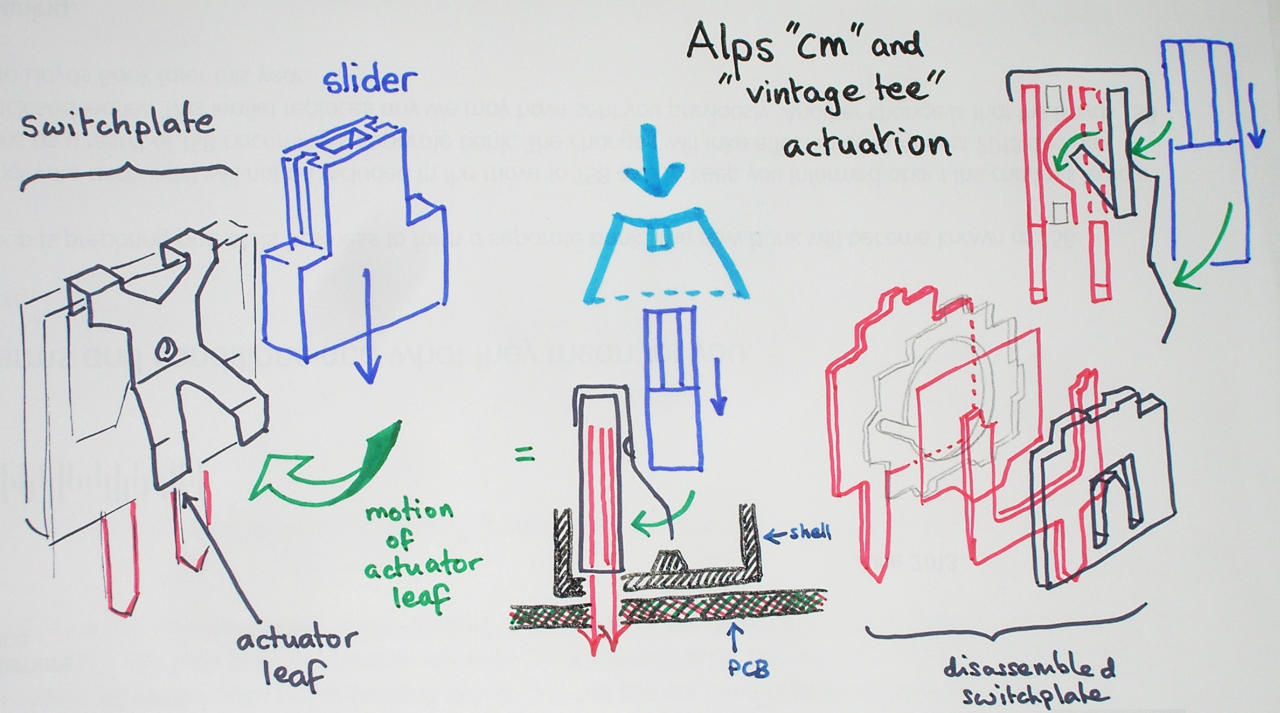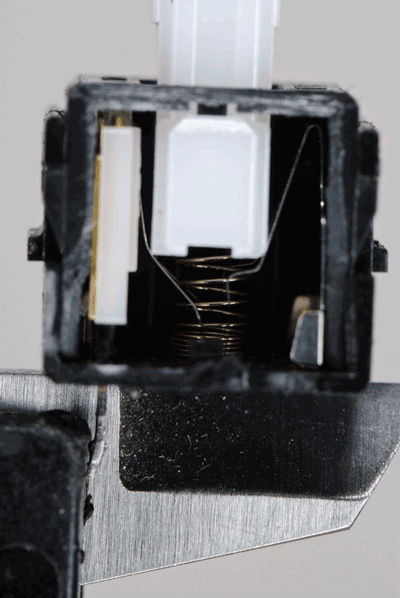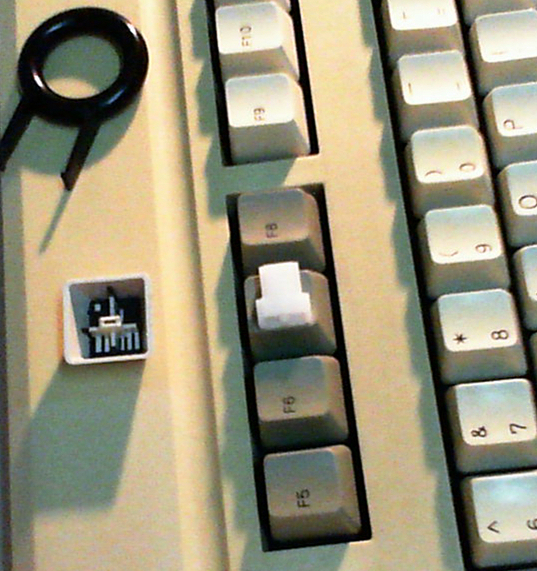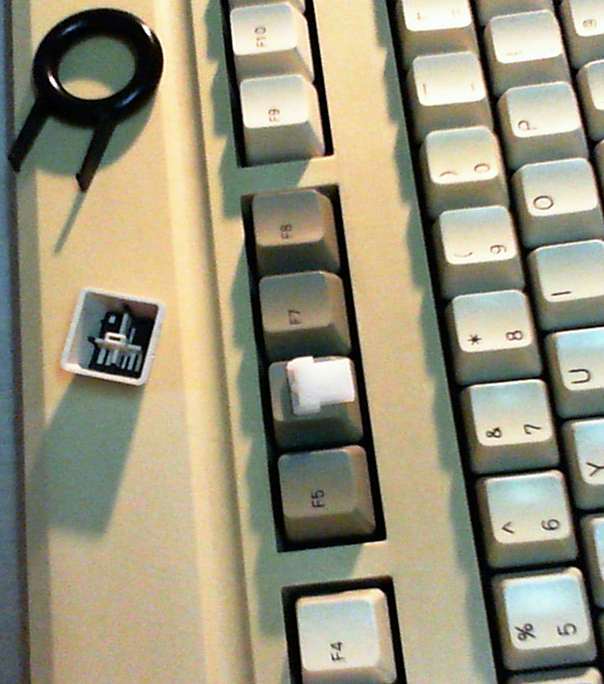Page 1 of 1
Enhancing blue alps
Posted: 21 Oct 2013, 22:25
by Laser
First - Hello, Deskthority forum users!
As i mentioned
here, i have a Chicony kb-5161 with blue alps. I think it is a great keyboard, with good keys, metal plate and quite nicely shaped (and only very very slightly yellowed). I also like the feeling of the blue alps, even if i compare them with my (new, modded) QFR with ghetto greens (which are very nice, so far). But there is *something* with the alps, i can not yet place into words, which lacks - perhaps it actuates "too sudden" and you have to be sure of your typing, so to speak. Anyway, my question is (and don't make me break my keyboard for it

), are there any known mods to "enhance" the feeling of a keyboard with blue alps?
Thanks
EDIT: to qualify the question a little, does it make any sense, for example, to change the springs of the switch?
Posted: 21 Oct 2013, 23:13
by bhtooefr
The early actuation is a core characteristic of how Alps switches behave, I'd say.
Cherry or Buckling Spring if you want later actuation.
Changing springs makes sense if you want to change force, but won't move the actuation point.
Posted: 21 Oct 2013, 23:23
by Laser
A-ha, thanks!
Perhaps with a stiffer string, won't the actuation point at least *feel* to kick in a bit later?
Posted: 21 Oct 2013, 23:41
by bhtooefr
It could, although that's a significant tradeoff in feel.
Posted: 22 Oct 2013, 01:26
by Daniel Beardsmore
Enhance blue Alps? How much better do you imagine they could be :-P
In Alps and Alps-style clicky switches, you have a folded sheet of metal called the "click leaf". As the key is depressed, the edge of the slider snags on a prominent folds on this leaf, and pulls the leaf in towards itself. When the slider has travelled far enough, it finally breaks clear of the leaf, which flies backwards and strikes the inside of the switch.
Nice diagrams here:
http://ex4.sakura.ne.jp/kb/tech_alps_bigfoot3.htm
I don't know of any way that you can alter the actuation point — that would be some feat. I did find that removing the actuator leaf from an Omron B3G-S series switch made it incredibly smooth, but then it won't work any more! There is no doubt room for improvement with the design, but it will be very time consuming.
Posted: 22 Oct 2013, 01:37
by Laser
Nice diagrams indeed!
(before going to sleep)
So, when the stem is pressed, it breaks the contact? If so, perhaps a "V-sharpened" stem bottom would delay the actuation somehow, if the contact would happen after a longer key travel. (just trying to understand)
Posted: 22 Oct 2013, 23:13
by Daniel Beardsmore
Who was that guy who was saying that we need more diagrams on the wiki? A 3D animation of an Alps switch would be interesting … ;-)
Here's a
very brief sketch to illustrate the complex electrical switch inside Alps "CM" and Alps vintage tee switches:

- Dodgy Alps sketch.jpg (163.84 KiB) Viewed 5065 times
From left to right:
• [wiki]Switchplate[/wiki] and slider, with the actuator leaf
• The slider presses on the protruding part of the actuator leaf, bending it inwards; a nub in the centre presses against the switchplate itself
• Exploded view of the switchplate (not accurate; I couldn't be bothered to find the exact order of the parts, but it's close enough for this) — a metal membrane sits in between two metal terminals, with a plastic spacer between the solid metal backplate and the plastic frontplate
• As the slider presses down on the actuator leaf, the nub on the leaf bends in a flap on the frontplate, and that bends the metal membrane inwards against the metal backplate, connecting the terminals
It's one of the most complex mechanical switching assemblies ever made, hence the term "complicated" Alps. Strictly speaking, "complicated" applies to both "CM" switches and to [wiki]Alps vintage tee mount[/wiki], which both use identical switchplates, but there's no "simplified" vintage tee switch. The other switch noted for this kind of design, which is even more complex, is the [wiki]Futaba complicated linear[/wiki], totalling 16 components to the switch.
Posted: 22 Oct 2013, 23:25
by Muirium
As "that guy", I endorse this sketch. Makes more sense than well labelled (but not annotated) photos of switch innards.
(Or do I mean vice versa? Words with arrows pointing to the picture = good!)
Posted: 22 Oct 2013, 23:54
by Daniel Beardsmore
Nah, it wasn't you … it was someone else.
Posted: 23 Oct 2013, 00:15
by Laser
That's a great explanation, thanks for the effort put into drawing it!
From the drawing, if somehow the slider would press "later" (or gradually) on the leaf, it still looks like the actuation would take place later. I am speculating, as i don't know about different alps (or clones), but if either the slider would be "thinner" at the base, or the leaf longer, this would contribute to the delay. Ideally, one would find such different pieces in another switch type, and just swap them with the similar parts in the blue alps.
Posted: 23 Oct 2013, 00:38
by Daniel Beardsmore
There's all sorts of things Alps never tried (surprising, considering how many designs they did manufacture!) For example, they made the mistake of driving the switch contacts home with the slider (putting a lot of excessive force on the leaf spring), whereas most switches allow the contacts to close under their own power. SMK also figured out that if you chamfer the bottom of the slider on the click leaf side, you can prevent the leaf from clicking (it's not pulled forward enough) yet retain the clean tactile feel of a click leaf.
I feel there's room for quite a lot of experimentation — one of the problems with all the Alps clones is that they're very formulaic, instead of looking for ways to improve on Alps's original design.
Posted: 23 Oct 2013, 01:39
by Laser
When i get the time, as i have a couple of additional white alps keyboards, i'll disassemble a switch from one, and (perhaps) sacrifice it for an experiment - to try to shorten the bottom of the slider with 1mm or so. When the key is not pressed, the spring should keep the shortened slider bottom part at a higher level than before, so it will have a longer travel until it "makes contact". Probably easier to say than to do; will see what happens in practice

Posted: 23 Oct 2013, 13:56
by Laser
Not quite a 3d animation, but perhaps close, i found this:

(by Ripster)
Posted: 23 Oct 2013, 14:00
by Game Theory
Laser wrote:Not quite a 3d animation, but perhaps close, i found this:
Nice find!
Posted: 23 Oct 2013, 15:04
by Halvar
Nice animation! Where did you find that? Proper credit should be given to someone who does something like this.
Posted: 23 Oct 2013, 15:12
by Laser
Halvar wrote:Nice animation! Where did you find that? Proper credit should be given to someone who does something like this.
Hm, quite true, i found it on this page:
http://carlosfenollosa.com/computers/keyboard/
(see the section where it says "This animation depicts" ... )
From the text, it *seems* that the author of the image could be the same ubiquitous
Ripster. Together with this slideshow:
http://imgur.com/a/elAFF/all (same author)
Posted: 02 Nov 2013, 21:45
by Laser
UPDATE: STEP 01 ~~~~~~~~~ Enhancing ... white alps ~~~~~~~~~~~~~~
So, before starting to waste a perfectly blue alps equipped keyboard, i decided to take things slowly, and use a disposable one which has white alps. Therefore - the first experiment was to take out the slider of a white alps switch, and file/polish it with sandpaper, taking out approximately 1 mm from the lower side, which is pushing the actuator leaf. Here are some atrocious potato pics, still better than nothing:

- mod-alps-01.jpg (367.26 KiB) Viewed 4852 times

- mod-alps-02.jpg (562.19 KiB) Viewed 4852 times

- mod-alps-03.jpg (492.3 KiB) Viewed 4852 times
And the first opinions:
I might try to sand *even* more from that lower side (i may try sanding both sides too), but for now, i can only say this: it seems to have a little longer travel before it actuates ( <--- my first goal), and it's also easier to press (you know, that feeling that it doesn't want to get pushed, it went away). Yay!

The sound pitch is now a tiny bit higher, and it is, if i can say so, "opened", compared to the default one.
But, i have 1. to see how does it feel for an entire keyboard (the one equipped with the whites, at first) and 2. to be careful - or find a reliable method - to sand all sliders as equal as possible. Or maybe i can find another slider (from a different alps switch) with a shorter "fat" portion.
If anyone finds it easy to give it a try (for one switch/slider), just test it - and give us a second opinion, to exterminate any placebo insects may fly around.
So, preliminary results - satisfactory! Quite satisfactory i might say

Posted: 02 Nov 2013, 22:28
by Laser
The update's update:
I forgot only one thing ... to test the key. The bad news was - if i file/sand/polish the slider only on one side, like in the above pictures, it will not push correctly/enough the actuator leaf every time. The GOOD news is - after i polished the slider on both sides (so the 'fat' lower side of the slider is shorter), the key also works perfectly well!
SOME MORE TESTS:
I bit the bullet and tested it on the blue alps keyboard, on such a switch. So i modded (shortened the base of) the blue slider, and tested it. It works, with the following observation: because the actuating resistance comes later, and you have some actual initial travel till that point, it is even easier to push the switch. So i replaced the spring with one from an white alps switch, and it feels 'better' (for me at least). It would also depend of the actual amount of slider base removed, in this case i exaggerated a little (~2mm), 1 mm should be enough.
So in the end, either i'll mod the white alps switch based keyboard, as i really like how the 'new' switch acts, or, for the blue version, i will also swap the springs with some stronger ones. Or, perhaps if i file/sand only 1mm of the slider base, i could also keep the default spring ...
TL;DR - White alps: shorten (file/sand) slider base, uniformly, 1mm. => Longer travel until actuation point, easy to press.
Posted: 03 Nov 2013, 14:10
by Daniel Beardsmore
See, the Japanese answer to this is to buy special little bottles of lube that they use on Alps switches. I suspect that would be the best option for blue Alps, as honestly the feel is too close to perfect to want to be grossly altering the sliders. A very small chamfer might help just overcome the little bit of balk in blues, but they're just about right otherwise.
It's white Alps that are seriously messed up and need all the help they can get.
Posted: 04 Nov 2013, 13:51
by Laser
The thing is, i can't get used to the high actuation point on the alps (the rest being perfect on the blues), and the mod seems to be solving that. I'll go on and change all the white alps sliders - and test them on both keyboards (white & blue alps). Will have to prepare another PS/2 cable, but i may be heading for perfection, so why not

 ), are there any known mods to "enhance" the feeling of a keyboard with blue alps?
), are there any known mods to "enhance" the feeling of a keyboard with blue alps? 